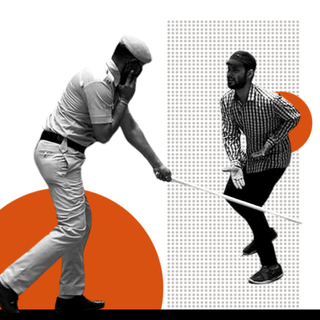
The Women’s Hockey Team Performance Is a Historic Moment For Indian Sports
The team lost to Great Britain 3-2, but the match was hard fought — on the fields and beyond it.

Today, 16 is a magic number. It’s the number of players Indian contingent of the women’s hockey team, who have scripted history by taking the team to the top four in the Tokyo Olympics. The performance is groundbreaking by every measure — it is a seminal moment in the history of Indian hockey and sports.
The team includes Rani Rampal (26), Neha Goyal (24), Nikki Pradhan (27), Nisha Warsi (26), Lalremsiami (21), Sushila Chanu (29), Deep Grace Ekka (27), Salima Tete (19), Udita Duhan (23), Vandana Katariya (26), Navneet Kaur (25), Monika Malik (27), Gurjit Kaur (25), Sharmila Devi (19), Navjot Kaur (26), and Savita Punia (31), along with coach Sjoerd Marijne.
This week, the matches, and the saga of the hockey team leave behind an important chapter. India’s best performance in the Olympics dates back to the 1980 Moscow Games — a year that also marked the debut of the women’s hockey team. It is 41 years later, and the team’s performance at the Olympics 2021 is one for the ages. Along with the men’s team’s bronze victory yesterday, many note how a solid foundation for hockey’s revival has been laid.
The journey during Tokyo Olympics has been nothing short of a nail-biter. India lost three games in a row to Netherlands, Germany, and Great Britain (GB) at the start. They beat Ireland and South Africa with late wins and qualified for the quarter-finals for the first time. They entered the semi-finals after a record win against Australia — a three-time gold medallist and the world no. 3. The defeat on Wednesday against Argentina led the team to compete against Great Britain today.
While GB won 4-3, an oral history of this moment in time will record the victory and pride Indians feel. Rani Rampal and the team’s tears may as well be echoed by a whole nation supporting them.
“Which makes their feat in Tokyo even stranger than fiction, with India having to face — and beat — such a dominant team so early in the tournament,” Jason Dosey noted in ABC.
While talking about Rani Rampal’s technique last year, Sharda Ugra noted how every move was methodical and a stroke of genius: “It is like an illusionist’s trick: in the initial melee of the D, she is not to be seen. Blink, and suddenly she is there.”
Every athlete in the team represents a story of hope and ambition, people who have risen out of struggles and humble backgrounds to reach where they are. Salima Tete, for instance, tells Mint Lounge: “My friends and I would remove the stones ourselves, try to make the ground as smooth as possible, and mark temporary goalposts,” she said.
Related on The Swaddle:
The Covid19 Pandemic Has Left Stadiums Empty. It’s An Opportunity to Boost Women’s Sports.
Rani Rampal, the team skipper, noted in a post: “I wanted an escape from my life; from the electricity shortages to the mosquitoes buzzing in our ear, from barely having two meals to seeing our home getting flooded. There was only so much my parents could do — Papa was a cart puller and Maa was a maid.”
Through every story of hard work and resilience, what comes out is how these athletes emerged successful in spite of institutional support, not because of it. And by support, we mean everything: the ability to navigate economic, social, gendered barriers.
The government cut the sports budget by almost Rs. 280 crores earlier this year, and many athletes and activists have commented on the lacking infrastructure in non-cricket sports. Several reports note how many athletes take loans just to keep playing, and continue to remain in debt.
Despite this lack of institutional support, many have rushed to claim the victories of the hockey team and other athletes at the Olympics. From Union Minister of Sports and Youth Affairs Anurag Thakur hailing P.V. Sindhu’s Olympian bronze as a result of the government’s Beti Bachao, Beti Padhao scheme to winners’ names and pictures being put up on banners, next to large images of the Prime Minister or chief ministers of the respective states they hail from. Mirabai Chanu, the first Indian to win a silver medal in Olympic weightlifting, was hailed “bharat ki beti.”
“Behind every successful sportsperson is not just sweat, tears, and impossible hard work — but a politician (or twenty) racing at full speed to take credit for her victory,” Indian Express noted in an editorial. The whole country plays a role in appropriating the athletes’ victory, but disassociating themselves when athletes lose — a trend more pronounced for athletes from marginalized backgrounds.
Beyond the superficial celebrations of medals and political acclaim is the need for greater funding, which will enable more athletes, from beyond tier 1 cities, to fulfill their dreams. Arguably, medals shouldn’t be the only way to get access to basic infrastructures like roads or electricity.
And more importantly, how we react to and perceive the display of brilliance today goes a long way in cultivating a culture of encouragement for women in sports. Perhaps no one expected the team to come this close to a medal; that is why the instinct has been to compare it to a Bollywood movie or draw comparison with male sports. “Most common problem the girls face is (lack of) self-confidence. Some of the girls feel a lot of pressure before the match. A few feel pressure from the family,” coach Marijne had said back in 2017.
The real athletes, their motivations, backgrounds, desires deserve all our attention even beyond victories and goals. They don’t have to shoot at the moon or reach the stars to wield respect, integrity, and support.
The message is that webelieve in them. This is an end and a beginning, historic all the same.
In a word, epic.
Saumya Kalia is an Associate Editor at The Swaddle. Her journalism and writing explore issues of social justice, digital sub-cultures, media ecosystem, literature, and memory as they cut across socio-cultural periods. You can reach her at @Saumya_Kalia.
Related


Forced Cremation of Dalit Rape Victim in Delhi Highlights Pattern of State’s Complicity in Caste‑Based Crimes
